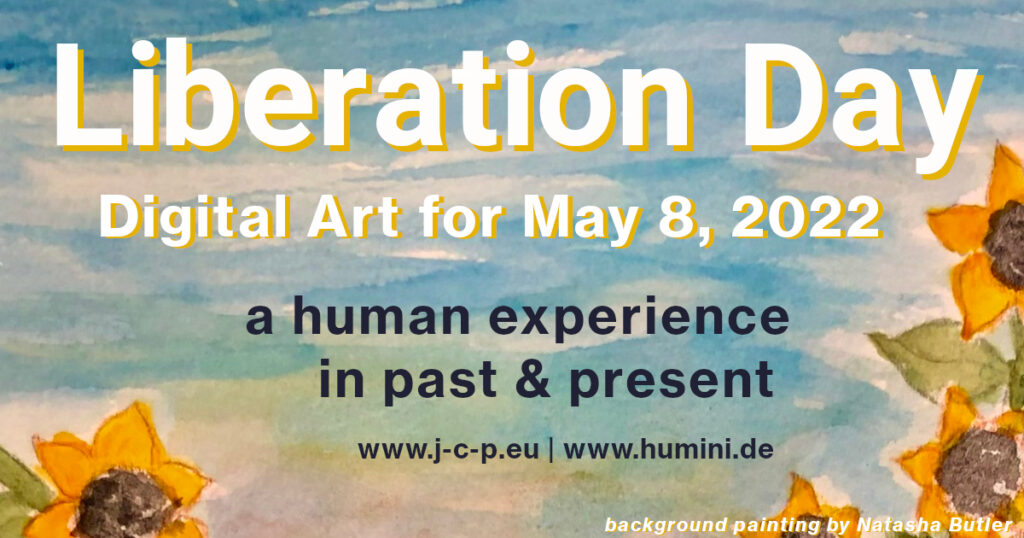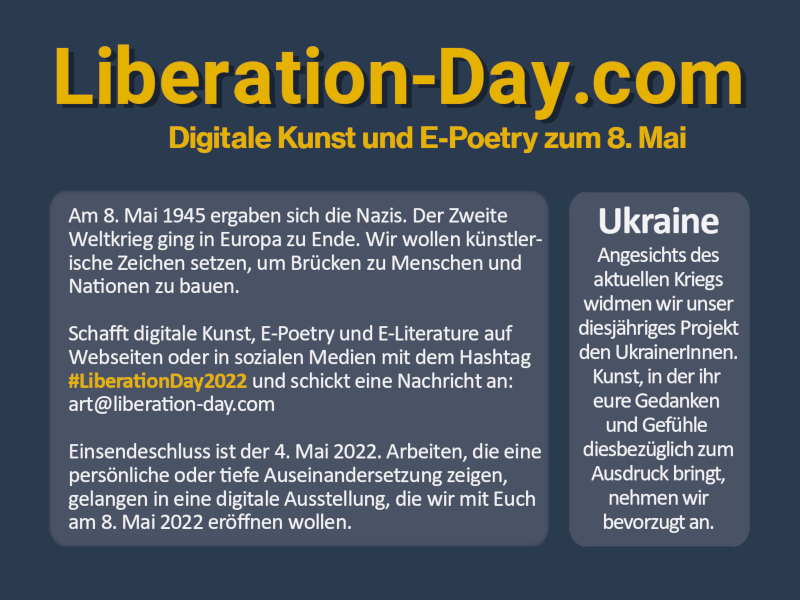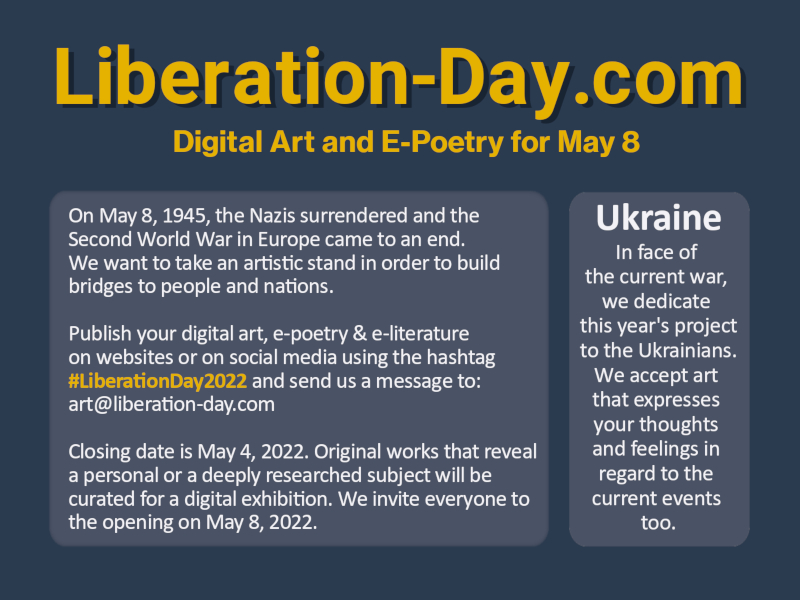The online exhibition has opened
Visit the exhibition on
humini.de in English.
Onlineausstellung ist eröffnet
Besuchen Sie die Ausstellung
auf humini.de in Deutsch.

Submission is now closed!
Below is the originial invitation
and some more inspiration.


Supported by
May 8 Initiative of Schleswig-Holstein;
Datenschleuder (magazine of the Chaos Computer Club);
Jan-Christian Petersen (writer, poet, journalist)
Invitation in English
What is Liberation Day about?
On May 8, 1945, the Nazis surrendered. The Second World War in Europe came to an end. We want to take an artistic stand in order to build bridges to people and nations.
Create digital art!
Images, text, music, voices, sound and video standing alone or in combination are wellcome. The challenge is to create art in awareness of the historical events.
Ukraine
In face of the current war, we dedicate this year’s project to the Ukrainians. We accept art that expresses your thoughts and feelings in regard to the current events too.
How to join?
Publish your digital art on websites or on social media with the hashtag #LiberationDay2022 and send us a message: art@liberation-day.com
Closing date is May 4 , 2022
Original works that reveal a personal or a deeply researched subject will be curated for a digital exhibition. All participants will be invited to join the online opening on May 8, 2022.
Einladung auf Deutsch
Was ist der Befreiungstag?
Am 8. Mai 1945 ergaben sich die Nazis. Der Zweite Weltkrieg ging in Europa zu Ende. Wir wollen künstlerische Zeichen setzen, um Brücken zu Menschen und Nationen zu bauen.
Schaffe digitale Kunst!
Bilder, Texte, Musik, Stimmen, Video einzeln oder kombiniert sind gefragt. Es gilt, Kunst im Bewusstsein der geschichtlichen Ereignisse zu schaffen.
Ukraine
Angesichts des aktuellen Kriegs widmen wir unser Projekt den UkrainerInnen. Kunst, in der Gedanken und Gefühle diesbezüglich zum Ausdruck gelangen, nehmen wir bevorzugt an.
Wie mache ich mit?
Poste deine Kunst auf Webseiten oder in sozialen Medien mit dem Hashtag #LiberationDay2022 und sende uns eine Nachricht: art@liberation-day.com
Einsendeschluss ist der 4.5.2022
Arbeiten, die eine persönliche oder tiefere Auseinandersetzung zeigen, gelangen in eine digitale Ausstellung. Alle Einsender werden zur Online-eröffnung am 8. Mai 2022 eingeladen.
Inspiration (english)
You don’t need programming skills. There are many ways to create poetic meaning. Go, explore:
»I love E-Poetry« – Leonardo Flores, President of the Electronic Literature Organization explains what e-poetry is.
»How to make a visual poem?« is a video introduction by the Getty Museum, Los Angeles.
»Thermidor« by John Dusenbury uses the App One Second Everyday for the video part. On Instagram, Dusenbury combines the video with the poem »The Waking« by Theodore Roethke.
»Dawn« consists of photos, texts and sounds by Alan Sondheim. This digital art was composed by Reiner Strasser in 2005. It has all the elements you can play with by using today’s tools and creator studios.
»297 Names« is an e-poem to remember the victims of the concentration camp Husum-Schwesing by Jan-Christian Petersen, Jan Girlich und Cylixe.
Inspiration (deutsch)
Du musst nicht zwingend programmieren können. Es gibt viele Wege, um Poesie zu schaffen. Probiere es aus:
»I love E-Poetry« – Leonardo Flores, Präsident der Electronic Literature Organization erklärt, was E-Poetry ist.
»How to make a visual poem?« ist eine Videoeinleitung des Getty Mu-seums, Los Angeles zur visuellen Poesie.
»Thermidor« von John Dusenbury nutzt die App One Second Everyday für den Videoteil. Dieser wird auf Instagram kombiniert mit dem Gedicht »The Waking« von Theodore Roethke.
»Dawn« enthält Fotos, Texte und Klänge von Alan Sondheim. Das digiale Kunstwerk wurde 2005 von Reiner Strasser komponiert. Alle Elemente lassen sich heute auch mit Gestaltungsprogrammen kombinieren.
»297 Namen« ist ein E-Gedicht, das den Opfern des KZ Husum-Schwesing gewidmet ist. Es stammt von Jan-Christian Petersen, Jan Girlich und Cylixe.
